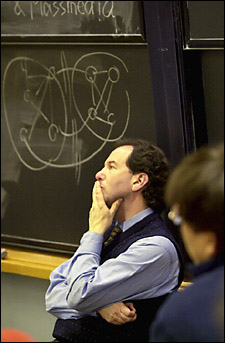KSG hosts Sino-Japanese dialogue
Students grapple with troubling issues
Can a roomful of Harvard students meeting for three hours on a Friday afternoon help to ease the deep historical tensions between China and Japan? Ronald Heifetz thinks so.

“The task before you is extraordinarily important. If you can make progress on this work and then go home and challenge your people, it will be an extraordinary achievement and a huge gift to your people.”
Heifetz, the King Hussein bin Talal Lecturer in Public Leadership at the Kennedy School of Government, was speaking May 6 to members of the Special Conference on China-Japan Dialogue. The students, many of whom were citizens of the two countries, were meeting for the third time in response to the recent anti-Japanese demonstrations in China. The demonstrations were triggered by the publication of a Japanese history textbook that Chinese critics claim whitewashes Japanese atrocities committed during the 1930s and ’40s.
Heifetz, known for his work on the practice and teaching of leadership, served as chair of the conference. In his opening remarks, he spoke of China and Japan as cultures with exceptionally deep roots in the past, something that can be seen as a limitation as well as a source of strength.
“Roots are meant to nurture the growth of the tree, but they also keep you in one place. Humans need to be able to respond with flexibility to current reality, to bring the best of their history into the future. This may involve some degree of tampering with the roots.”
Heifetz told the students that their job would be to help one another refashion their culture’s historical narrative, a difficult task since at any time a word or phrase spoken by someone on the other side might touch on deep feelings of loyalty and trigger an intense emotional response.
Even after negotiating this stage of the process, the students faced an even more difficult task, Heifetz said – challenging prevailing opinion in their home countries.
“There will be pressure on you to be pulled back, as if by a huge rubber band, to abandon what you’ve accomplished here in return for the warm feeling of belonging. You must be willing to sacrifice some of that warmth, and for that you will need each other’s wisdom.”
Following Heifetz’s remarks, students from each side delivered short keynote speeches. Speaking for the Japanese students, Taku Otsuka said that the average Japanese knows about the atrocities committed against China and believes that Japan should apologize.
“However, in the face of repeated Chinese demands for apology, many of us feel that these demands may be a bit too much, and that the Communist government uses anti-Japanese sentiment as a way of uniting their country.”
Speaking for the Chinese side, Lyndon Cao said that China’s suffering at the hands of the Japanese is a stigma that no one can forget and that any denial of the atrocities would arouse anger among the Chinese.
“But we should all look at the big picture. Like it or not, we are neighbors. We are both East Asian countries, and we have a lot in common. If we cooperate, we will both gain.”
In the second hour, the students separated into groups to discuss various topics – history, economics, security, and communications and mass media. The history group was the most well-attended as well as the most emotionally charged.
“There was a feeling that it should be like that,” said Tatsuya Nishida, one of the group’s participants. “We decided to go directly into the most sensitive issues, because you really couldn’t avoid them.”
Chief among these was the 1937 Massacre of Nanjing, in which as many as 300,000 Chinese, most of them civilians, were killed by invading Japanese forces. According to Nishida, the first half of the discussion was predictably stormy, with each side hurling accusations at the other.
“Finally, some of the American students said that this was not very helpful, and I think this helped to change the discussion,” Nishida said. “Instead of blaming each other, we realized it might be more constructive to look at our own problems.”
According to Cindy Zheng, who also participated in the history group, an Austrian student broadened the discussion further by drawing a parallel with the legacy of Nazism and an American brought up a comparison with the Catholic-Protestant conflict in Northern Ireland. Despite the raised voices, Zheng was positive about the overall effect of the discussion.
“We hope the dialogue will generate a positive impact among students from both sides and among students in the Kennedy School student community,” she said.
Juno Nakamura, who participated in the communications and mass media group, reported that the students in her group learned a great deal from each other. Japanese students were astonished to learn of the existence of a tabloid press in China that carries more sensationalistic reporting than the government press and was chiefly responsible for whipping up anti-Japanese sentiment. The Chinese side was taken aback by news that nearly one-half the Japanese people disapproved of Prime Minister Koizumi’s recent controversial visit to Tokyo’s Yasukuni shrine, which commemorates a number of war criminals among other military dead.
“I thought it was very productive on both sides,” Nakamura said.
While many agreed that the conference had been generally positive, there was also agreement that it was but one step along a very long road, a notion best summed up by Heifetz:
“This is an opportunity to form partnerships that will help your people to lay this history to rest. It will require leadership that will take at least your lifetimes, and maybe many lifetimes.”




